Portfolio of Strategic Planning and Personal Reflection Report
VerifiedAdded on 2022/11/29
|9
|2740
|261
Report
AI Summary
This report presents a comprehensive analysis of strategic planning and personal reflection, focusing on Marks and Spencer as a case study. It begins with an introduction to strategic planning, highlighting its importance for organizational growth. Part A (1) evaluates Marks and Spencer's competitive strengths, including its use of RFID technology, sustainable practices, and market position. It also identifies areas for improvement, such as adapting to changing consumer preferences and online experience. Part A (2) provides a company overview, including its mission, vision, values, and objectives. It then delves into the Ansoff matrix, exploring market penetration, market development, product development, and diversification strategies. Furthermore, the report applies Porter's five forces model to analyze the competitive landscape, assessing the threat of new entrants, bargaining power of suppliers and buyers, threat of substitutes, and rivalry among existing firms. Part B offers a personal reflection on online learning and the application of holistic marketing, highlighting insights gained and their relevance to career development. The report concludes with a summary of the key findings and recommendations for strategic planning.
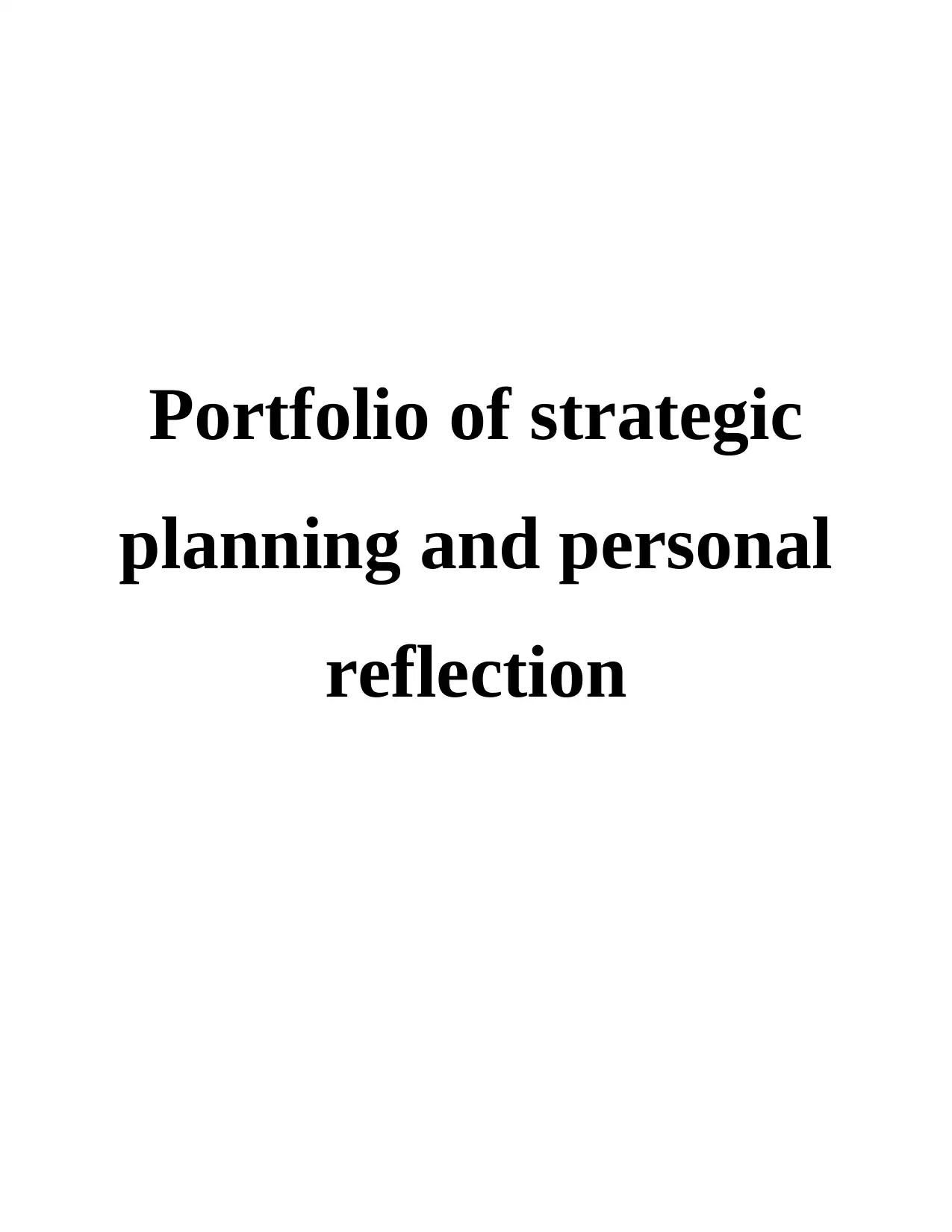
Portfolio of strategic
planning and personal
reflection
planning and personal
reflection
Paraphrase This Document
Need a fresh take? Get an instant paraphrase of this document with our AI Paraphraser
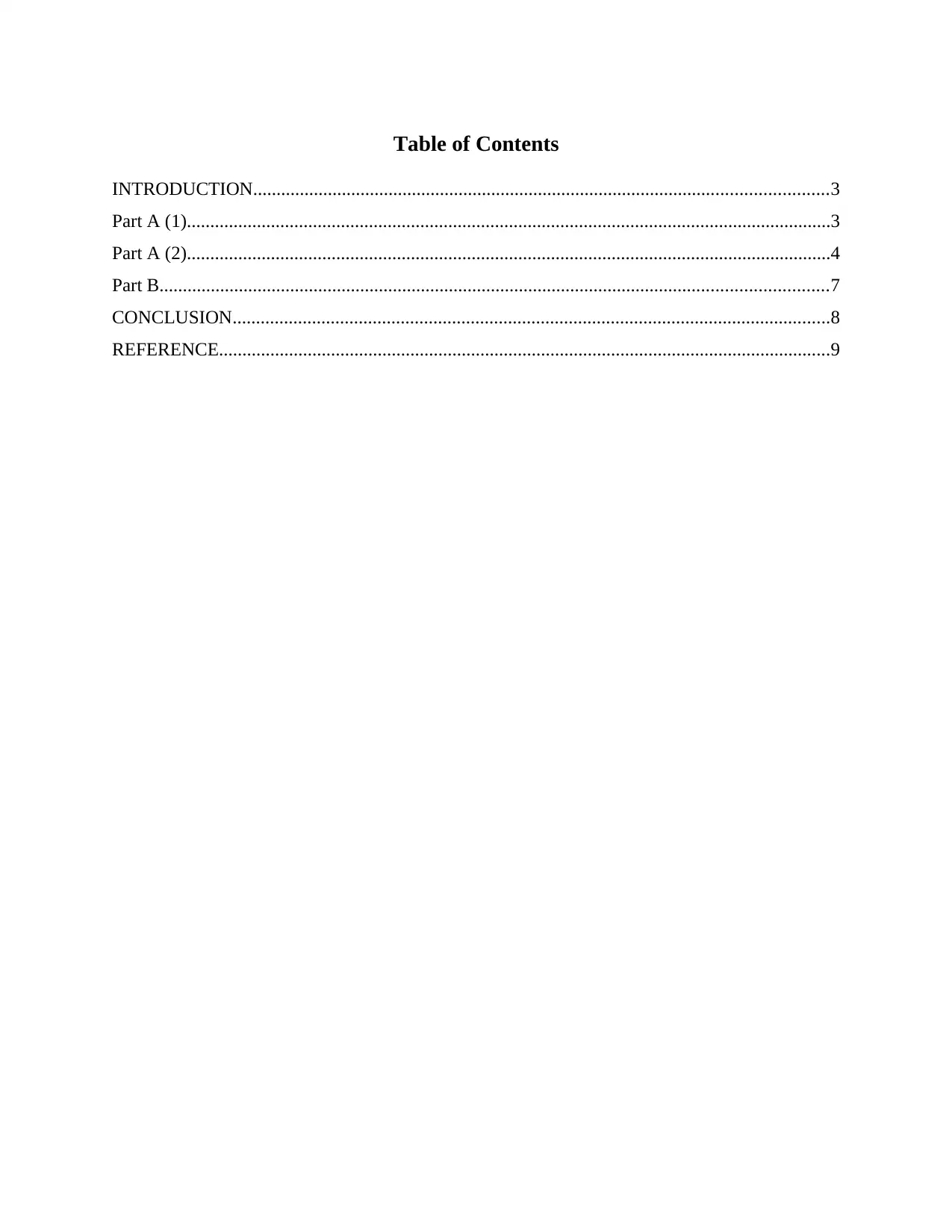
Table of Contents
INTRODUCTION...........................................................................................................................3
Part A (1)..........................................................................................................................................3
Part A (2)..........................................................................................................................................4
Part B...............................................................................................................................................7
CONCLUSION................................................................................................................................8
REFERENCE...................................................................................................................................9
INTRODUCTION...........................................................................................................................3
Part A (1)..........................................................................................................................................3
Part A (2)..........................................................................................................................................4
Part B...............................................................................................................................................7
CONCLUSION................................................................................................................................8
REFERENCE...................................................................................................................................9
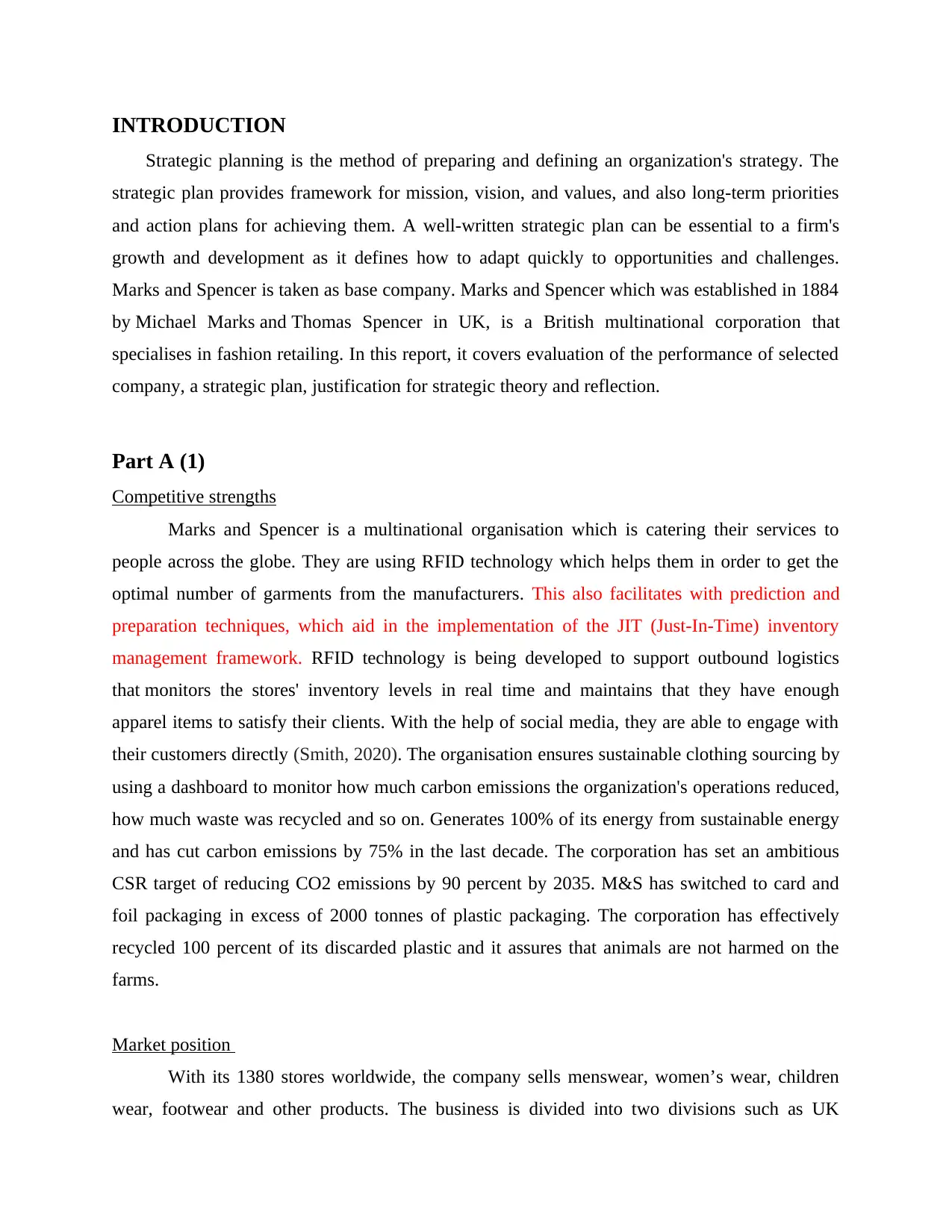
INTRODUCTION
Strategic planning is the method of preparing and defining an organization's strategy. The
strategic plan provides framework for mission, vision, and values, and also long-term priorities
and action plans for achieving them. A well-written strategic plan can be essential to a firm's
growth and development as it defines how to adapt quickly to opportunities and challenges.
Marks and Spencer is taken as base company. Marks and Spencer which was established in 1884
by Michael Marks and Thomas Spencer in UK, is a British multinational corporation that
specialises in fashion retailing. In this report, it covers evaluation of the performance of selected
company, a strategic plan, justification for strategic theory and reflection.
Part A (1)
Competitive strengths
Marks and Spencer is a multinational organisation which is catering their services to
people across the globe. They are using RFID technology which helps them in order to get the
optimal number of garments from the manufacturers. This also facilitates with prediction and
preparation techniques, which aid in the implementation of the JIT (Just-In-Time) inventory
management framework. RFID technology is being developed to support outbound logistics
that monitors the stores' inventory levels in real time and maintains that they have enough
apparel items to satisfy their clients. With the help of social media, they are able to engage with
their customers directly (Smith, 2020). The organisation ensures sustainable clothing sourcing by
using a dashboard to monitor how much carbon emissions the organization's operations reduced,
how much waste was recycled and so on. Generates 100% of its energy from sustainable energy
and has cut carbon emissions by 75% in the last decade. The corporation has set an ambitious
CSR target of reducing CO2 emissions by 90 percent by 2035. M&S has switched to card and
foil packaging in excess of 2000 tonnes of plastic packaging. The corporation has effectively
recycled 100 percent of its discarded plastic and it assures that animals are not harmed on the
farms.
Market position
With its 1380 stores worldwide, the company sells menswear, women’s wear, children
wear, footwear and other products. The business is divided into two divisions such as UK
Strategic planning is the method of preparing and defining an organization's strategy. The
strategic plan provides framework for mission, vision, and values, and also long-term priorities
and action plans for achieving them. A well-written strategic plan can be essential to a firm's
growth and development as it defines how to adapt quickly to opportunities and challenges.
Marks and Spencer is taken as base company. Marks and Spencer which was established in 1884
by Michael Marks and Thomas Spencer in UK, is a British multinational corporation that
specialises in fashion retailing. In this report, it covers evaluation of the performance of selected
company, a strategic plan, justification for strategic theory and reflection.
Part A (1)
Competitive strengths
Marks and Spencer is a multinational organisation which is catering their services to
people across the globe. They are using RFID technology which helps them in order to get the
optimal number of garments from the manufacturers. This also facilitates with prediction and
preparation techniques, which aid in the implementation of the JIT (Just-In-Time) inventory
management framework. RFID technology is being developed to support outbound logistics
that monitors the stores' inventory levels in real time and maintains that they have enough
apparel items to satisfy their clients. With the help of social media, they are able to engage with
their customers directly (Smith, 2020). The organisation ensures sustainable clothing sourcing by
using a dashboard to monitor how much carbon emissions the organization's operations reduced,
how much waste was recycled and so on. Generates 100% of its energy from sustainable energy
and has cut carbon emissions by 75% in the last decade. The corporation has set an ambitious
CSR target of reducing CO2 emissions by 90 percent by 2035. M&S has switched to card and
foil packaging in excess of 2000 tonnes of plastic packaging. The corporation has effectively
recycled 100 percent of its discarded plastic and it assures that animals are not harmed on the
farms.
Market position
With its 1380 stores worldwide, the company sells menswear, women’s wear, children
wear, footwear and other products. The business is divided into two divisions such as UK
⊘ This is a preview!⊘
Do you want full access?
Subscribe today to unlock all pages.

Trusted by 1+ million students worldwide
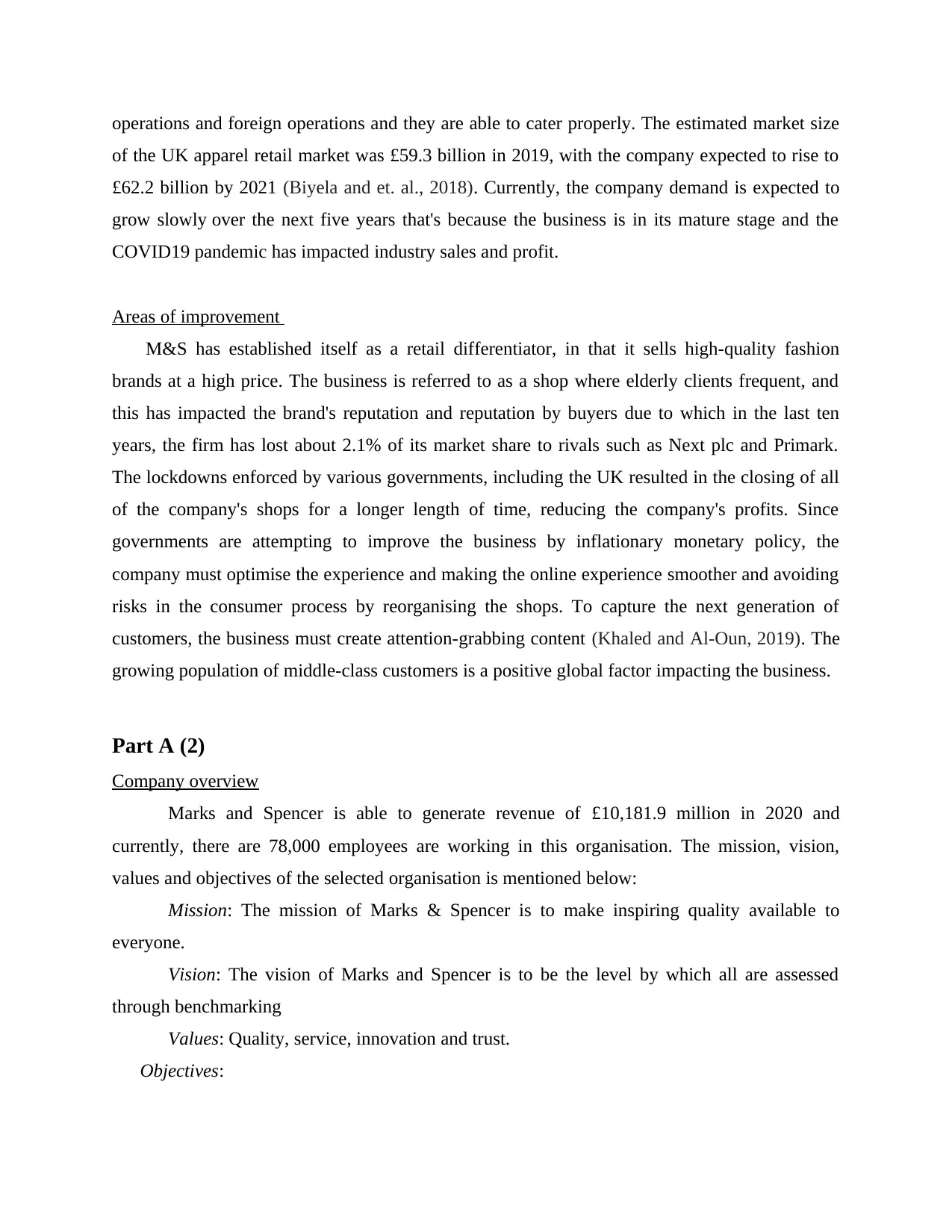
operations and foreign operations and they are able to cater properly. The estimated market size
of the UK apparel retail market was £59.3 billion in 2019, with the company expected to rise to
£62.2 billion by 2021 (Biyela and et. al., 2018). Currently, the company demand is expected to
grow slowly over the next five years that's because the business is in its mature stage and the
COVID19 pandemic has impacted industry sales and profit.
Areas of improvement
M&S has established itself as a retail differentiator, in that it sells high-quality fashion
brands at a high price. The business is referred to as a shop where elderly clients frequent, and
this has impacted the brand's reputation and reputation by buyers due to which in the last ten
years, the firm has lost about 2.1% of its market share to rivals such as Next plc and Primark.
The lockdowns enforced by various governments, including the UK resulted in the closing of all
of the company's shops for a longer length of time, reducing the company's profits. Since
governments are attempting to improve the business by inflationary monetary policy, the
company must optimise the experience and making the online experience smoother and avoiding
risks in the consumer process by reorganising the shops. To capture the next generation of
customers, the business must create attention-grabbing content (Khaled and Al-Oun, 2019). The
growing population of middle-class customers is a positive global factor impacting the business.
Part A (2)
Company overview
Marks and Spencer is able to generate revenue of £10,181.9 million in 2020 and
currently, there are 78,000 employees are working in this organisation. The mission, vision,
values and objectives of the selected organisation is mentioned below:
Mission: The mission of Marks & Spencer is to make inspiring quality available to
everyone.
Vision: The vision of Marks and Spencer is to be the level by which all are assessed
through benchmarking
Values: Quality, service, innovation and trust.
Objectives:
of the UK apparel retail market was £59.3 billion in 2019, with the company expected to rise to
£62.2 billion by 2021 (Biyela and et. al., 2018). Currently, the company demand is expected to
grow slowly over the next five years that's because the business is in its mature stage and the
COVID19 pandemic has impacted industry sales and profit.
Areas of improvement
M&S has established itself as a retail differentiator, in that it sells high-quality fashion
brands at a high price. The business is referred to as a shop where elderly clients frequent, and
this has impacted the brand's reputation and reputation by buyers due to which in the last ten
years, the firm has lost about 2.1% of its market share to rivals such as Next plc and Primark.
The lockdowns enforced by various governments, including the UK resulted in the closing of all
of the company's shops for a longer length of time, reducing the company's profits. Since
governments are attempting to improve the business by inflationary monetary policy, the
company must optimise the experience and making the online experience smoother and avoiding
risks in the consumer process by reorganising the shops. To capture the next generation of
customers, the business must create attention-grabbing content (Khaled and Al-Oun, 2019). The
growing population of middle-class customers is a positive global factor impacting the business.
Part A (2)
Company overview
Marks and Spencer is able to generate revenue of £10,181.9 million in 2020 and
currently, there are 78,000 employees are working in this organisation. The mission, vision,
values and objectives of the selected organisation is mentioned below:
Mission: The mission of Marks & Spencer is to make inspiring quality available to
everyone.
Vision: The vision of Marks and Spencer is to be the level by which all are assessed
through benchmarking
Values: Quality, service, innovation and trust.
Objectives:
Paraphrase This Document
Need a fresh take? Get an instant paraphrase of this document with our AI Paraphraser
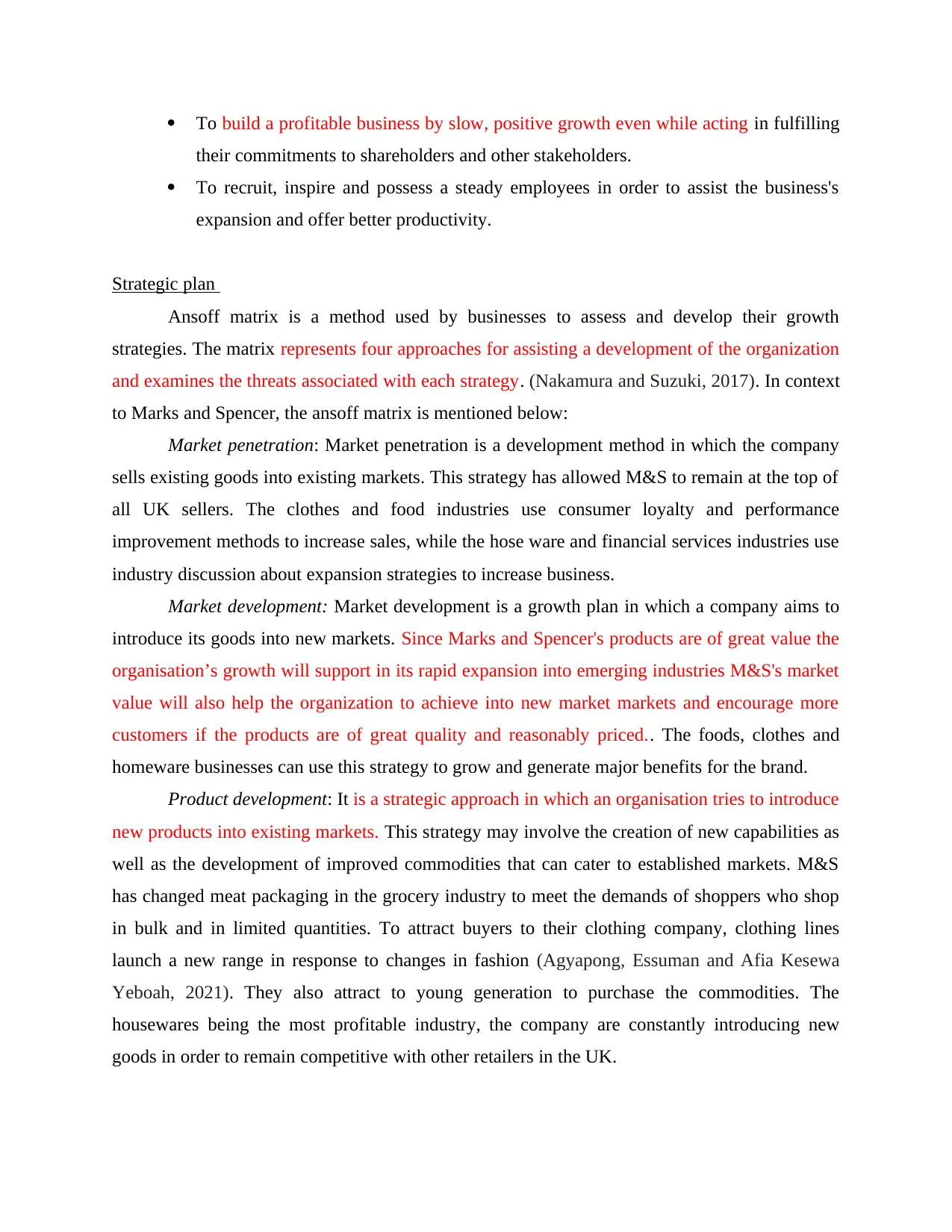
To build a profitable business by slow, positive growth even while acting in fulfilling
their commitments to shareholders and other stakeholders.
To recruit, inspire and possess a steady employees in order to assist the business's
expansion and offer better productivity.
Strategic plan
Ansoff matrix is a method used by businesses to assess and develop their growth
strategies. The matrix represents four approaches for assisting a development of the organization
and examines the threats associated with each strategy. (Nakamura and Suzuki, 2017). In context
to Marks and Spencer, the ansoff matrix is mentioned below:
Market penetration: Market penetration is a development method in which the company
sells existing goods into existing markets. This strategy has allowed M&S to remain at the top of
all UK sellers. The clothes and food industries use consumer loyalty and performance
improvement methods to increase sales, while the hose ware and financial services industries use
industry discussion about expansion strategies to increase business.
Market development: Market development is a growth plan in which a company aims to
introduce its goods into new markets. Since Marks and Spencer's products are of great value the
organisation’s growth will support in its rapid expansion into emerging industries M&S's market
value will also help the organization to achieve into new market markets and encourage more
customers if the products are of great quality and reasonably priced.. The foods, clothes and
homeware businesses can use this strategy to grow and generate major benefits for the brand.
Product development: It is a strategic approach in which an organisation tries to introduce
new products into existing markets. This strategy may involve the creation of new capabilities as
well as the development of improved commodities that can cater to established markets. M&S
has changed meat packaging in the grocery industry to meet the demands of shoppers who shop
in bulk and in limited quantities. To attract buyers to their clothing company, clothing lines
launch a new range in response to changes in fashion (Agyapong, Essuman and Afia Kesewa
Yeboah, 2021). They also attract to young generation to purchase the commodities. The
housewares being the most profitable industry, the company are constantly introducing new
goods in order to remain competitive with other retailers in the UK.
their commitments to shareholders and other stakeholders.
To recruit, inspire and possess a steady employees in order to assist the business's
expansion and offer better productivity.
Strategic plan
Ansoff matrix is a method used by businesses to assess and develop their growth
strategies. The matrix represents four approaches for assisting a development of the organization
and examines the threats associated with each strategy. (Nakamura and Suzuki, 2017). In context
to Marks and Spencer, the ansoff matrix is mentioned below:
Market penetration: Market penetration is a development method in which the company
sells existing goods into existing markets. This strategy has allowed M&S to remain at the top of
all UK sellers. The clothes and food industries use consumer loyalty and performance
improvement methods to increase sales, while the hose ware and financial services industries use
industry discussion about expansion strategies to increase business.
Market development: Market development is a growth plan in which a company aims to
introduce its goods into new markets. Since Marks and Spencer's products are of great value the
organisation’s growth will support in its rapid expansion into emerging industries M&S's market
value will also help the organization to achieve into new market markets and encourage more
customers if the products are of great quality and reasonably priced.. The foods, clothes and
homeware businesses can use this strategy to grow and generate major benefits for the brand.
Product development: It is a strategic approach in which an organisation tries to introduce
new products into existing markets. This strategy may involve the creation of new capabilities as
well as the development of improved commodities that can cater to established markets. M&S
has changed meat packaging in the grocery industry to meet the demands of shoppers who shop
in bulk and in limited quantities. To attract buyers to their clothing company, clothing lines
launch a new range in response to changes in fashion (Agyapong, Essuman and Afia Kesewa
Yeboah, 2021). They also attract to young generation to purchase the commodities. The
housewares being the most profitable industry, the company are constantly introducing new
goods in order to remain competitive with other retailers in the UK.
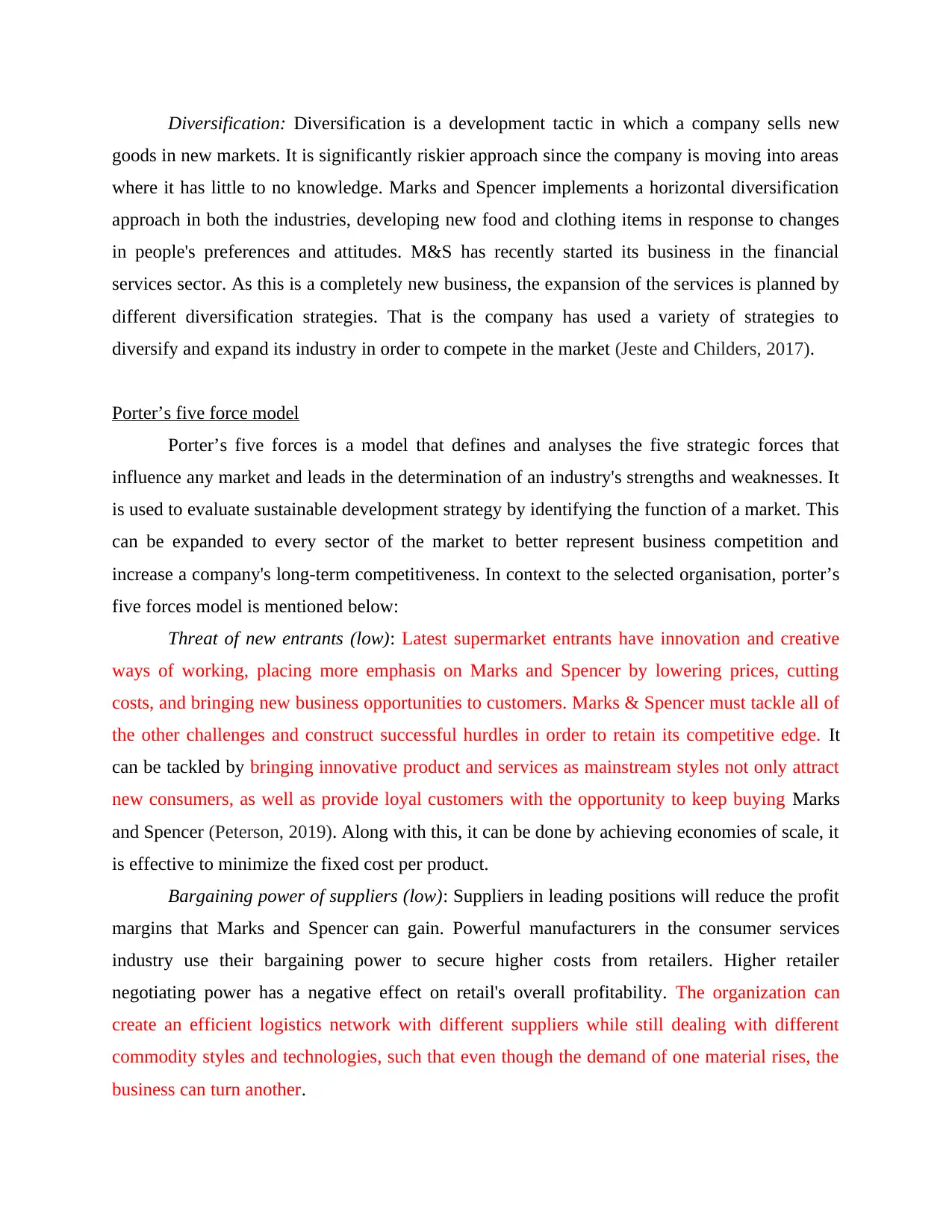
Diversification: Diversification is a development tactic in which a company sells new
goods in new markets. It is significantly riskier approach since the company is moving into areas
where it has little to no knowledge. Marks and Spencer implements a horizontal diversification
approach in both the industries, developing new food and clothing items in response to changes
in people's preferences and attitudes. M&S has recently started its business in the financial
services sector. As this is a completely new business, the expansion of the services is planned by
different diversification strategies. That is the company has used a variety of strategies to
diversify and expand its industry in order to compete in the market (Jeste and Childers, 2017).
Porter’s five force model
Porter’s five forces is a model that defines and analyses the five strategic forces that
influence any market and leads in the determination of an industry's strengths and weaknesses. It
is used to evaluate sustainable development strategy by identifying the function of a market. This
can be expanded to every sector of the market to better represent business competition and
increase a company's long-term competitiveness. In context to the selected organisation, porter’s
five forces model is mentioned below:
Threat of new entrants (low): Latest supermarket entrants have innovation and creative
ways of working, placing more emphasis on Marks and Spencer by lowering prices, cutting
costs, and bringing new business opportunities to customers. Marks & Spencer must tackle all of
the other challenges and construct successful hurdles in order to retain its competitive edge. It
can be tackled by bringing innovative product and services as mainstream styles not only attract
new consumers, as well as provide loyal customers with the opportunity to keep buying Marks
and Spencer (Peterson, 2019). Along with this, it can be done by achieving economies of scale, it
is effective to minimize the fixed cost per product.
Bargaining power of suppliers (low): Suppliers in leading positions will reduce the profit
margins that Marks and Spencer can gain. Powerful manufacturers in the consumer services
industry use their bargaining power to secure higher costs from retailers. Higher retailer
negotiating power has a negative effect on retail's overall profitability. The organization can
create an efficient logistics network with different suppliers while still dealing with different
commodity styles and technologies, such that even though the demand of one material rises, the
business can turn another.
goods in new markets. It is significantly riskier approach since the company is moving into areas
where it has little to no knowledge. Marks and Spencer implements a horizontal diversification
approach in both the industries, developing new food and clothing items in response to changes
in people's preferences and attitudes. M&S has recently started its business in the financial
services sector. As this is a completely new business, the expansion of the services is planned by
different diversification strategies. That is the company has used a variety of strategies to
diversify and expand its industry in order to compete in the market (Jeste and Childers, 2017).
Porter’s five force model
Porter’s five forces is a model that defines and analyses the five strategic forces that
influence any market and leads in the determination of an industry's strengths and weaknesses. It
is used to evaluate sustainable development strategy by identifying the function of a market. This
can be expanded to every sector of the market to better represent business competition and
increase a company's long-term competitiveness. In context to the selected organisation, porter’s
five forces model is mentioned below:
Threat of new entrants (low): Latest supermarket entrants have innovation and creative
ways of working, placing more emphasis on Marks and Spencer by lowering prices, cutting
costs, and bringing new business opportunities to customers. Marks & Spencer must tackle all of
the other challenges and construct successful hurdles in order to retain its competitive edge. It
can be tackled by bringing innovative product and services as mainstream styles not only attract
new consumers, as well as provide loyal customers with the opportunity to keep buying Marks
and Spencer (Peterson, 2019). Along with this, it can be done by achieving economies of scale, it
is effective to minimize the fixed cost per product.
Bargaining power of suppliers (low): Suppliers in leading positions will reduce the profit
margins that Marks and Spencer can gain. Powerful manufacturers in the consumer services
industry use their bargaining power to secure higher costs from retailers. Higher retailer
negotiating power has a negative effect on retail's overall profitability. The organization can
create an efficient logistics network with different suppliers while still dealing with different
commodity styles and technologies, such that even though the demand of one material rises, the
business can turn another.
⊘ This is a preview!⊘
Do you want full access?
Subscribe today to unlock all pages.

Trusted by 1+ million students worldwide
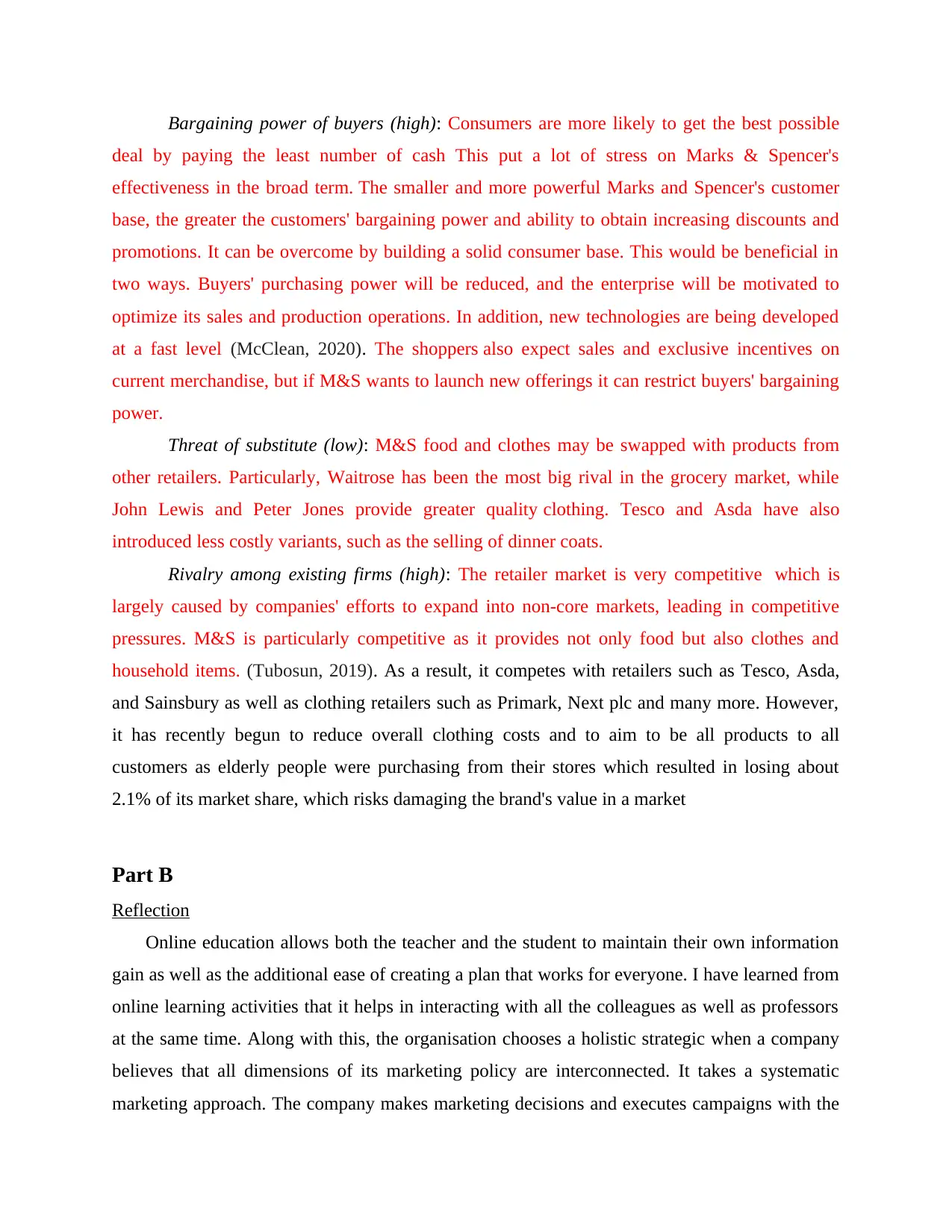
Bargaining power of buyers (high): Consumers are more likely to get the best possible
deal by paying the least number of cash This put a lot of stress on Marks & Spencer's
effectiveness in the broad term. The smaller and more powerful Marks and Spencer's customer
base, the greater the customers' bargaining power and ability to obtain increasing discounts and
promotions. It can be overcome by building a solid consumer base. This would be beneficial in
two ways. Buyers' purchasing power will be reduced, and the enterprise will be motivated to
optimize its sales and production operations. In addition, new technologies are being developed
at a fast level (McClean, 2020). The shoppers also expect sales and exclusive incentives on
current merchandise, but if M&S wants to launch new offerings it can restrict buyers' bargaining
power.
Threat of substitute (low): M&S food and clothes may be swapped with products from
other retailers. Particularly, Waitrose has been the most big rival in the grocery market, while
John Lewis and Peter Jones provide greater quality clothing. Tesco and Asda have also
introduced less costly variants, such as the selling of dinner coats.
Rivalry among existing firms (high): The retailer market is very competitive which is
largely caused by companies' efforts to expand into non-core markets, leading in competitive
pressures. M&S is particularly competitive as it provides not only food but also clothes and
household items. (Tubosun, 2019). As a result, it competes with retailers such as Tesco, Asda,
and Sainsbury as well as clothing retailers such as Primark, Next plc and many more. However,
it has recently begun to reduce overall clothing costs and to aim to be all products to all
customers as elderly people were purchasing from their stores which resulted in losing about
2.1% of its market share, which risks damaging the brand's value in a market
Part B
Reflection
Online education allows both the teacher and the student to maintain their own information
gain as well as the additional ease of creating a plan that works for everyone. I have learned from
online learning activities that it helps in interacting with all the colleagues as well as professors
at the same time. Along with this, the organisation chooses a holistic strategic when a company
believes that all dimensions of its marketing policy are interconnected. It takes a systematic
marketing approach. The company makes marketing decisions and executes campaigns with the
deal by paying the least number of cash This put a lot of stress on Marks & Spencer's
effectiveness in the broad term. The smaller and more powerful Marks and Spencer's customer
base, the greater the customers' bargaining power and ability to obtain increasing discounts and
promotions. It can be overcome by building a solid consumer base. This would be beneficial in
two ways. Buyers' purchasing power will be reduced, and the enterprise will be motivated to
optimize its sales and production operations. In addition, new technologies are being developed
at a fast level (McClean, 2020). The shoppers also expect sales and exclusive incentives on
current merchandise, but if M&S wants to launch new offerings it can restrict buyers' bargaining
power.
Threat of substitute (low): M&S food and clothes may be swapped with products from
other retailers. Particularly, Waitrose has been the most big rival in the grocery market, while
John Lewis and Peter Jones provide greater quality clothing. Tesco and Asda have also
introduced less costly variants, such as the selling of dinner coats.
Rivalry among existing firms (high): The retailer market is very competitive which is
largely caused by companies' efforts to expand into non-core markets, leading in competitive
pressures. M&S is particularly competitive as it provides not only food but also clothes and
household items. (Tubosun, 2019). As a result, it competes with retailers such as Tesco, Asda,
and Sainsbury as well as clothing retailers such as Primark, Next plc and many more. However,
it has recently begun to reduce overall clothing costs and to aim to be all products to all
customers as elderly people were purchasing from their stores which resulted in losing about
2.1% of its market share, which risks damaging the brand's value in a market
Part B
Reflection
Online education allows both the teacher and the student to maintain their own information
gain as well as the additional ease of creating a plan that works for everyone. I have learned from
online learning activities that it helps in interacting with all the colleagues as well as professors
at the same time. Along with this, the organisation chooses a holistic strategic when a company
believes that all dimensions of its marketing policy are interconnected. It takes a systematic
marketing approach. The company makes marketing decisions and executes campaigns with the
Paraphrase This Document
Need a fresh take? Get an instant paraphrase of this document with our AI Paraphraser
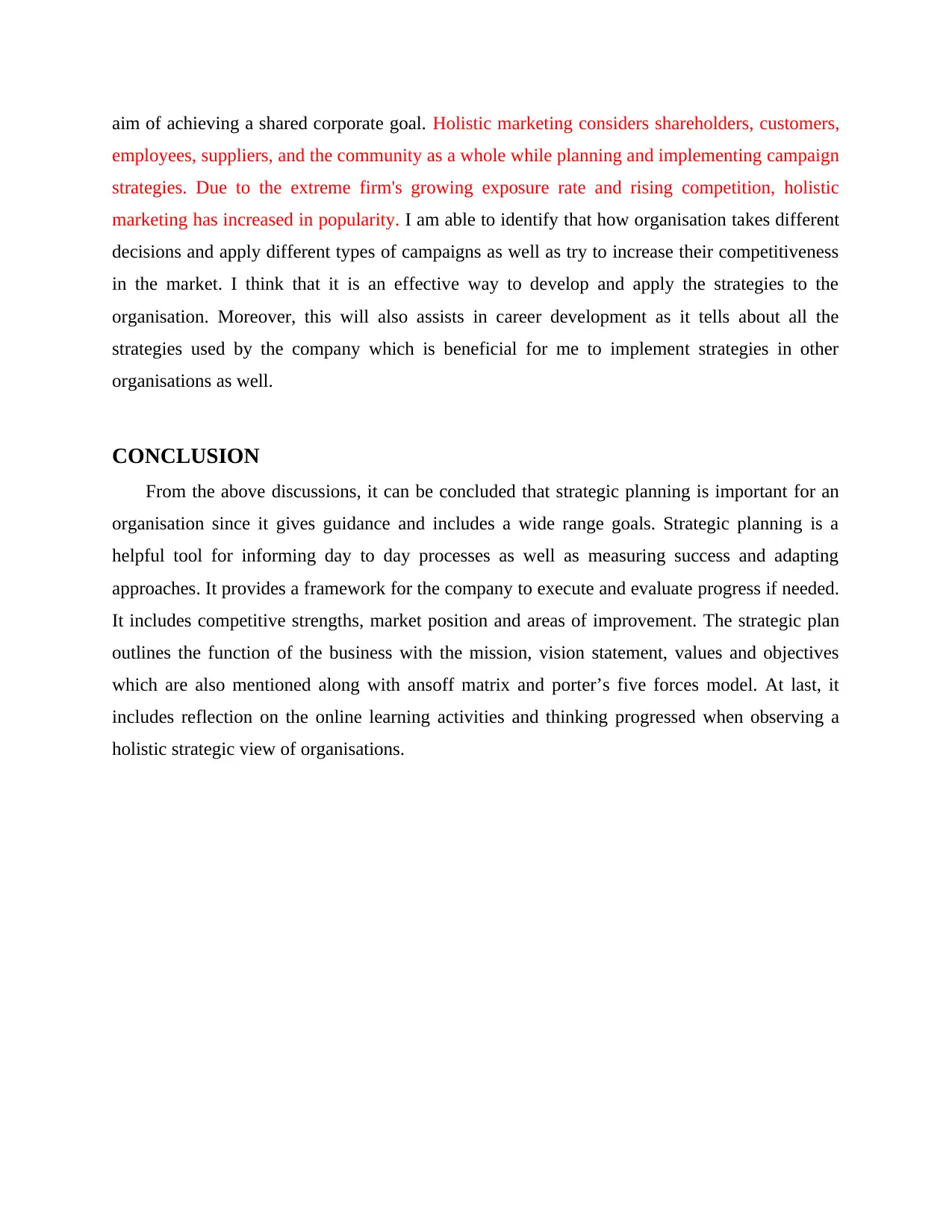
aim of achieving a shared corporate goal. Holistic marketing considers shareholders, customers,
employees, suppliers, and the community as a whole while planning and implementing campaign
strategies. Due to the extreme firm's growing exposure rate and rising competition, holistic
marketing has increased in popularity. I am able to identify that how organisation takes different
decisions and apply different types of campaigns as well as try to increase their competitiveness
in the market. I think that it is an effective way to develop and apply the strategies to the
organisation. Moreover, this will also assists in career development as it tells about all the
strategies used by the company which is beneficial for me to implement strategies in other
organisations as well.
CONCLUSION
From the above discussions, it can be concluded that strategic planning is important for an
organisation since it gives guidance and includes a wide range goals. Strategic planning is a
helpful tool for informing day to day processes as well as measuring success and adapting
approaches. It provides a framework for the company to execute and evaluate progress if needed.
It includes competitive strengths, market position and areas of improvement. The strategic plan
outlines the function of the business with the mission, vision statement, values and objectives
which are also mentioned along with ansoff matrix and porter’s five forces model. At last, it
includes reflection on the online learning activities and thinking progressed when observing a
holistic strategic view of organisations.
employees, suppliers, and the community as a whole while planning and implementing campaign
strategies. Due to the extreme firm's growing exposure rate and rising competition, holistic
marketing has increased in popularity. I am able to identify that how organisation takes different
decisions and apply different types of campaigns as well as try to increase their competitiveness
in the market. I think that it is an effective way to develop and apply the strategies to the
organisation. Moreover, this will also assists in career development as it tells about all the
strategies used by the company which is beneficial for me to implement strategies in other
organisations as well.
CONCLUSION
From the above discussions, it can be concluded that strategic planning is important for an
organisation since it gives guidance and includes a wide range goals. Strategic planning is a
helpful tool for informing day to day processes as well as measuring success and adapting
approaches. It provides a framework for the company to execute and evaluate progress if needed.
It includes competitive strengths, market position and areas of improvement. The strategic plan
outlines the function of the business with the mission, vision statement, values and objectives
which are also mentioned along with ansoff matrix and porter’s five forces model. At last, it
includes reflection on the online learning activities and thinking progressed when observing a
holistic strategic view of organisations.
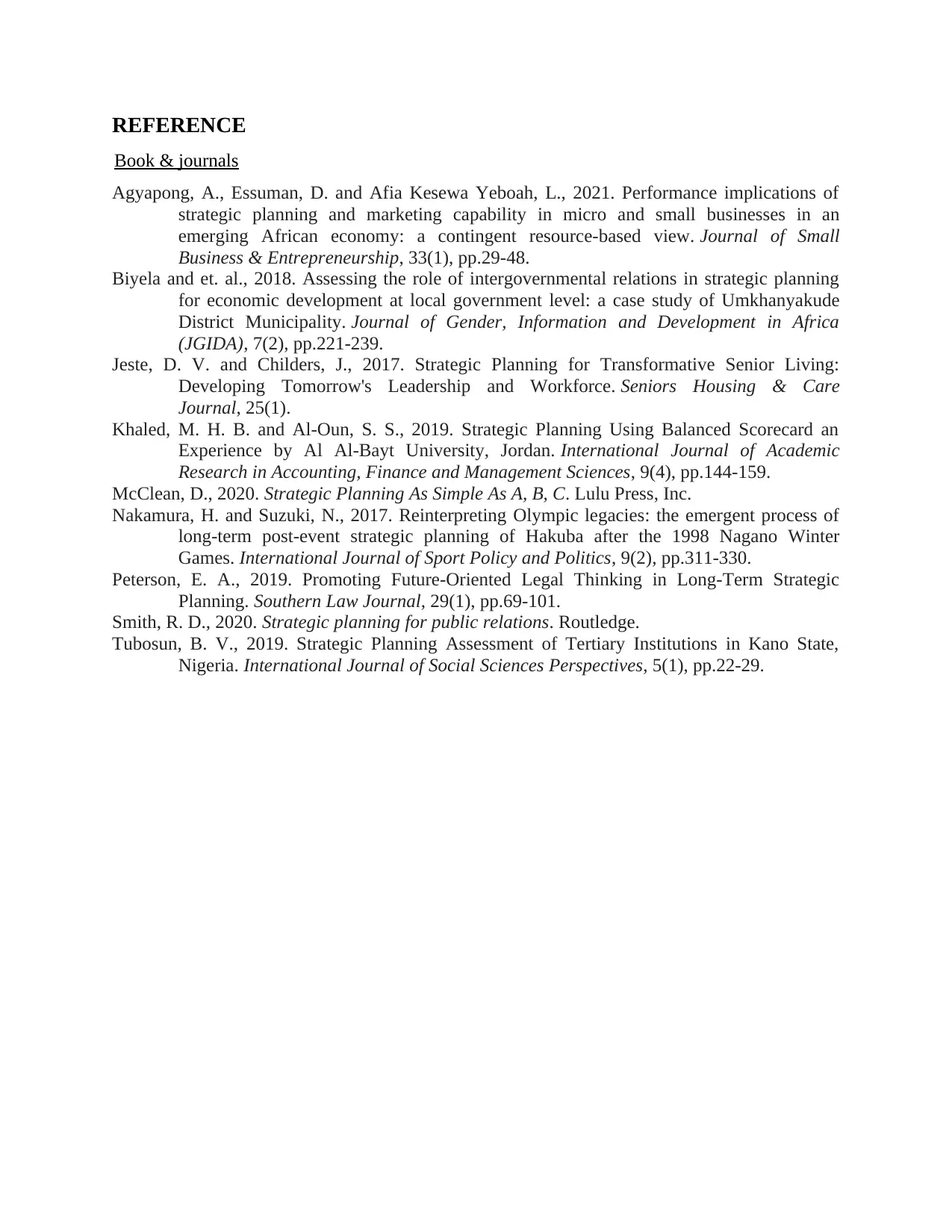
REFERENCE
Book & journals
Agyapong, A., Essuman, D. and Afia Kesewa Yeboah, L., 2021. Performance implications of
strategic planning and marketing capability in micro and small businesses in an
emerging African economy: a contingent resource-based view. Journal of Small
Business & Entrepreneurship, 33(1), pp.29-48.
Biyela and et. al., 2018. Assessing the role of intergovernmental relations in strategic planning
for economic development at local government level: a case study of Umkhanyakude
District Municipality. Journal of Gender, Information and Development in Africa
(JGIDA), 7(2), pp.221-239.
Jeste, D. V. and Childers, J., 2017. Strategic Planning for Transformative Senior Living:
Developing Tomorrow's Leadership and Workforce. Seniors Housing & Care
Journal, 25(1).
Khaled, M. H. B. and Al-Oun, S. S., 2019. Strategic Planning Using Balanced Scorecard an
Experience by Al Al-Bayt University, Jordan. International Journal of Academic
Research in Accounting, Finance and Management Sciences, 9(4), pp.144-159.
McClean, D., 2020. Strategic Planning As Simple As A, B, C. Lulu Press, Inc.
Nakamura, H. and Suzuki, N., 2017. Reinterpreting Olympic legacies: the emergent process of
long-term post-event strategic planning of Hakuba after the 1998 Nagano Winter
Games. International Journal of Sport Policy and Politics, 9(2), pp.311-330.
Peterson, E. A., 2019. Promoting Future-Oriented Legal Thinking in Long-Term Strategic
Planning. Southern Law Journal, 29(1), pp.69-101.
Smith, R. D., 2020. Strategic planning for public relations. Routledge.
Tubosun, B. V., 2019. Strategic Planning Assessment of Tertiary Institutions in Kano State,
Nigeria. International Journal of Social Sciences Perspectives, 5(1), pp.22-29.
Book & journals
Agyapong, A., Essuman, D. and Afia Kesewa Yeboah, L., 2021. Performance implications of
strategic planning and marketing capability in micro and small businesses in an
emerging African economy: a contingent resource-based view. Journal of Small
Business & Entrepreneurship, 33(1), pp.29-48.
Biyela and et. al., 2018. Assessing the role of intergovernmental relations in strategic planning
for economic development at local government level: a case study of Umkhanyakude
District Municipality. Journal of Gender, Information and Development in Africa
(JGIDA), 7(2), pp.221-239.
Jeste, D. V. and Childers, J., 2017. Strategic Planning for Transformative Senior Living:
Developing Tomorrow's Leadership and Workforce. Seniors Housing & Care
Journal, 25(1).
Khaled, M. H. B. and Al-Oun, S. S., 2019. Strategic Planning Using Balanced Scorecard an
Experience by Al Al-Bayt University, Jordan. International Journal of Academic
Research in Accounting, Finance and Management Sciences, 9(4), pp.144-159.
McClean, D., 2020. Strategic Planning As Simple As A, B, C. Lulu Press, Inc.
Nakamura, H. and Suzuki, N., 2017. Reinterpreting Olympic legacies: the emergent process of
long-term post-event strategic planning of Hakuba after the 1998 Nagano Winter
Games. International Journal of Sport Policy and Politics, 9(2), pp.311-330.
Peterson, E. A., 2019. Promoting Future-Oriented Legal Thinking in Long-Term Strategic
Planning. Southern Law Journal, 29(1), pp.69-101.
Smith, R. D., 2020. Strategic planning for public relations. Routledge.
Tubosun, B. V., 2019. Strategic Planning Assessment of Tertiary Institutions in Kano State,
Nigeria. International Journal of Social Sciences Perspectives, 5(1), pp.22-29.
⊘ This is a preview!⊘
Do you want full access?
Subscribe today to unlock all pages.

Trusted by 1+ million students worldwide
1 out of 9
Related Documents
Your All-in-One AI-Powered Toolkit for Academic Success.
+13062052269
info@desklib.com
Available 24*7 on WhatsApp / Email
![[object Object]](/_next/static/media/star-bottom.7253800d.svg)
Unlock your academic potential
Copyright © 2020–2025 A2Z Services. All Rights Reserved. Developed and managed by ZUCOL.





